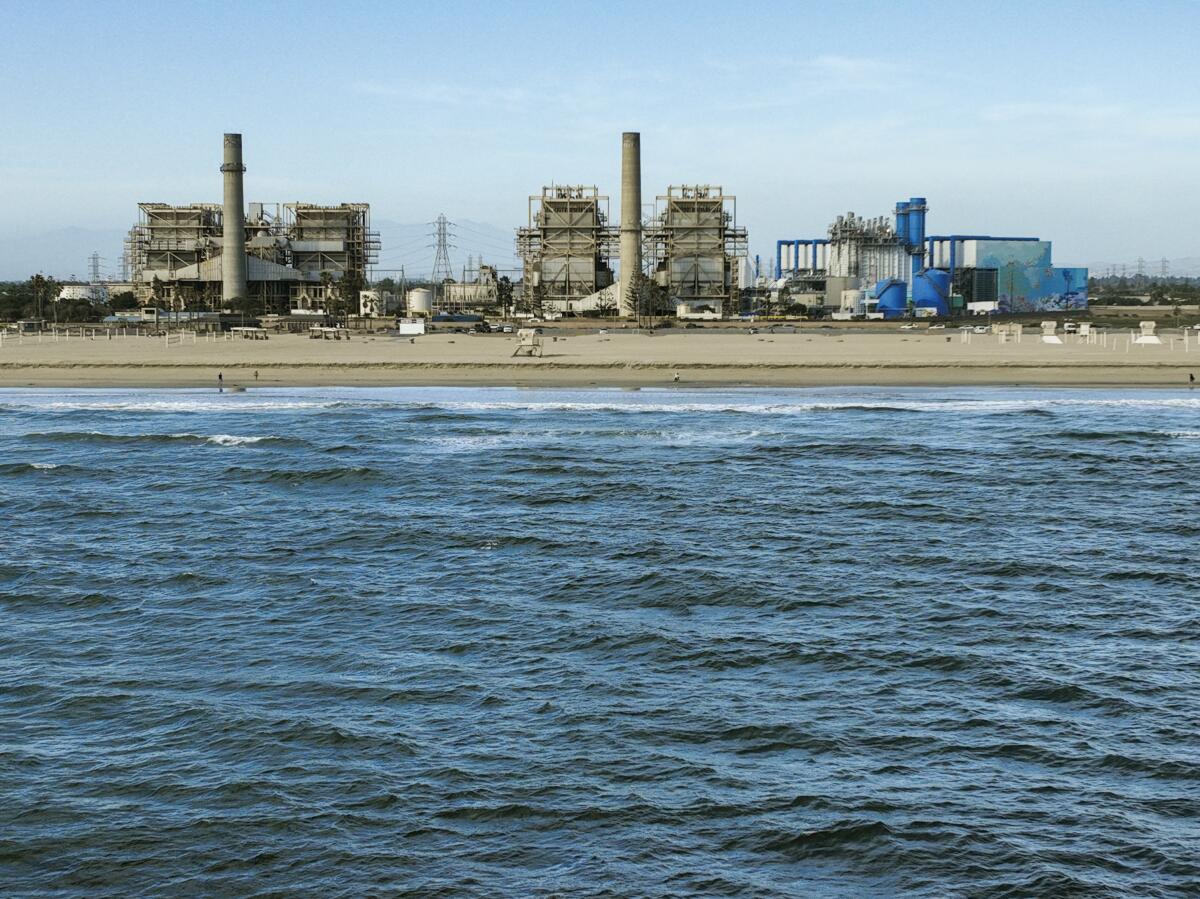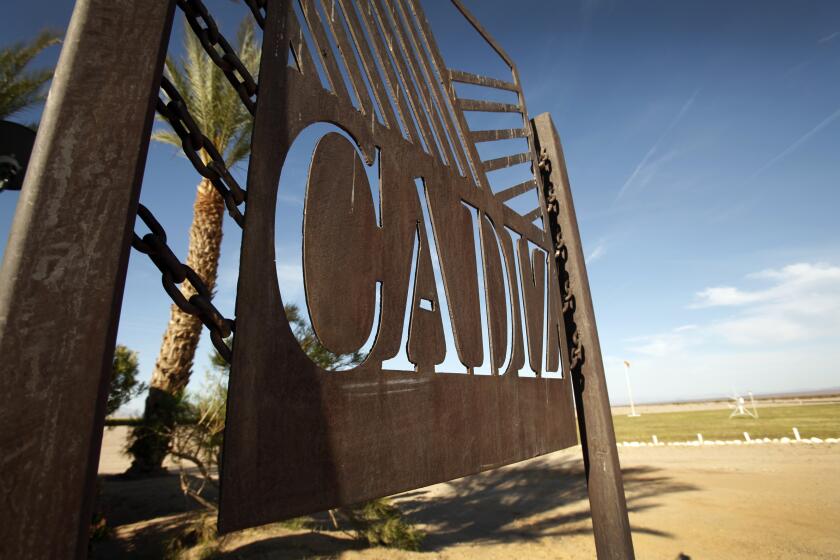Column: It’s time to kill this useless and costly desalination project

When it comes to wasteful, overpriced and ill-considered proposals to address California’s water supply issues, it’s hard to know where to start.
But a good place would be the plan to build a desalination plant on the Pacific coast at Huntington Beach. As my colleague Ian James has reported, the project, which is sponsored by the politically wired and private-equity-owned firm Poseidon Water, will be coming up for a crucial vote by the California Coastal Commission on May 12.
The vote represents the best opportunity to drive a stake through the heart of the project once and for all. The commission should have its mallet at the ready.
Political leaders don’t take the time to look at whether something is the right plan. Unfortunately, sometimes they are only talking to the project promoters.
— Ron Gastelum, former general manager, Metropolitan Water District
The commission’s staff already has given the panel’s members all the ammunition they need by recommending rejection in a blistering 200-page report issued April 25.
As I’ve reported in the past, there isn’t much to recommend the Huntington Beach project. It would seriously damage the marine coastal environment, produce the costliest water of any source available and raise water bills for residents and businesses.
Get the latest from Michael Hiltzik
Commentary on economics and more from a Pulitzer Prize winner.
You may occasionally receive promotional content from the Los Angeles Times.
Poseidon has made clear that it can’t build the $1.4-billion plant without huge subsidies from the public purse, including $400 million from the Metropolitan Water District and $1.1 billion in state government-backed bonds.
At this moment, Poseidon doesn’t even have a customer for the plant’s output. The firm holds only a nonbinding agreement with the Orange County Water District, which serves about 2.5 million residents, reached in 2018.
At that time, the district estimated that Poseidon water would exceed the cost of water from the Metropolitan Water District of Southern California, its principal outside source, by about 45%, or $536 per acre-foot, this year. (An acre-foot is about 326,000 gallons, or enough to supply the needs of one or two California families for a year.)
The MWD expects the cost of its water to increase by a little more than 4% annually on average for the next 10 years; at that rate, Poseidon water would remain more expensive than the MWD supply well into the 2050s.
Poseidon acknowledges that the plant might drive up the average household water bill in Orange County by $3 to $6 per month — or as much as 8.6%.
A 2019 study by researchers at UCLA found that these costs, like almost all utility costs, would fall most heavily on disadvantaged households, for whom drinking water would become “moderately to severely less affordable.”
You can surmise that a business is running into trouble when it starts lining up political firepower.
To the extent there’s any controversy about the wisdom of the Poseidon project, it reflects a disagreement between the state’s political leaders, including Gov. Gavin Newsom, a strong supporter of the proposal, and the water districts that are actually responsible for serving customers.
“Political leaders don’t take the time to look at whether something is the right plan,” says Ron Gastelum, the former general manager of the Metropolitan Water District, who is assisting the organizations fighting the project. “Unfortunately, sometimes they are only talking to the project promoters.”
The water districts, on the other hand, have signaled their distaste for the proposal. “They’re not signing up with their dollars and they’re making public statements that they don’t need this project,” Gastelum told me.
A few words here about the technical aspects of the Poseidon plant, which has been proposed for 20 years. Desalination of seawater seems superficially to be a no-brainer as a solution to water shortages in California. After all, the big blue Pacific Ocean washes up on our shores, and the technology to convert seawater to fresh water by removing its salt isn’t especially novel.
Accordingly, Poseidon and its backers say the plant would provide a “drought-proof” water supply for Orange County. The plant would be located at the site of a soon-to-be-mothballed Huntington Beach power plant, using its ocean intakes and outflow pipes to suck in seawater and discharge wastewater.
The goal would be for the plant to convert about 107 million gallons a day of seawater into about 50 million gallons a day of potable water. The heavily oversalted brine would be piped back into the ocean.
Things aren’t that simple. The same phenomenon that exacerbates droughts in Southern California — global warming — also represents a threat to the plant. That’s because the plant, located a bit more than a football field’s distance from the ocean, will be exposed to the ravages of rising sea level.
Commission staff acknowledged that Poseidon’s plan is to raise the elevation of the plant to the point that it would be safe from flooding “except in extreme, worst-case scenarios.” But the staff also observed that the surrounding area could be vulnerable to regular flooding within a couple of decades, rendering the plant unreachable during emergencies.
As surely as the hot, dry Santa Ana winds bring blue skies to the coast and wildfires to the hills, severe California droughts bring calls to build desalination plants up and down the seashore.
Poseidon’s location, the staff wrote, “is likely to become isolated and difficult or impossible to access during coastal hazard events that are almost certain to increase in severity and frequency in the future.”
The commission staff and other critics have been pointing out for years that the plant poses a dire threat to the coastal ecosystem. The discharge would kill marine life in a large marine zone. Poseidon has proposed mitigation projects in local wetlands to offset the damage, but the commission staff found those proposals to be of “limited ... value.”
The project’s negative impact is so great and the opportunity for mitigation so meager, the staff reported, that the proposals didn’t appear to be feasible. In any case, the staff observed, the mitigation program would take so long to design and build that the plant would be operating for as long as 15 years without any mitigation at all.
As it happens, the experience at Poseidon’s desalination plant in Carlsbad, which began operating in 2015, suggests that mitigation projects are illusory. Although the Coastal Commission ordered the mitigation program when it approved the Carlsbad plant in 2008, an environmental contractor was not even hired until this February and construction work isn’t due to begin until September.
“As a result,” the staff wrote, “the Carlsbad plant has been operating for six years without mitigation in place, resulting in significant long-term losses to the state’s marine resources.” Poseidon told me the mitigation delays were due to changing government standards and new requirements for permits.
More generally, Poseidon says that the commission staff “erred in its recommendation” for rejection. The firm paints rejection in apocalyptic terms: “If this recommendation stands, it will effectively be the death knell for desalination in California.”
The Huntington Beach project’s importance to its sponsors is illustrated by the money they’ve doled out for political influence. Since 2001, or about as long as the project has been on the drawing board, Poseidon has spent nearly $2.7 million on lobbying the Legislature and state agencies, according to state disclosure reports.
The Cadiz water scheme has been a dead-project-walking for two decades. Biden may finally put it in the grave.
During that time, the company has placed some very influential politicians on its payroll, including former Sen. Barbara Boxer and Kathleen Brown, former Gov. Jerry Brown’s sister.
There are also signs that Poseidon has its hooks into Gov. Gavin Newsom. It may be recalled that Newsom got into heaps of trouble in late 2020 when he was caught attending a dinner party at the French Laundry restaurant in Napa Valley at the same time he was implementing anti-pandemic policies that discouraged precisely such gatherings.
What may be forgotten is that the party was a birthday celebration for Jason Kinney — a Newsom fixer and Poseidon lobbyist.
Newsom has consistently pushed for the project, to the extent of replacing an anti-Poseidon member of the Santa Ana Regional Water Quality Control Board with a politician who had received campaign funding from pro-Poseidon labor groups.
Last year, members of that board were forced to disclose a series of back-door contacts they received from Newsom’s environmental protection secretary, Jared Blumenfeld, in which Blumenfeld plainly leaned on them to favor the project.
Newsom doubled down on his support last week during a meeting with the editorial board of the Bay Area News Group, telling them that a commission vote killing the project would be “a big mistake.”
He stated, “We need more tools in the damn tool kit. ... What more evidence do you need that you need to have more tools in the tool kit than what we’ve experienced? Seven out of the last 10 years have been severe drought.”
It was obvious even during the presidential campaign that Donald Trump didn’t know much about water policy and didn’t have much inclination to learn.
The best that can be said about Newsom’s remark is that it’s a non sequitur: It’s one thing to have desalination in the water supply tool kit but quite another to have this project in the tool kit.
Poseidon is owned by the Canadian investment firm Brookfield Asset Management. In 2018, Brookfield did a big favor for the family of then-President Trump’s son-in-law, Jared Kushner, by effectively taking a heavily indebted Manhattan office building off the Kushners’ hands.
The following year, the Poseidon project won a coveted $585-million loan from Trump’s Environmental Protection Agency. A Brookfield spokesman says the investment opportunity in the Manhattan deal was “the sole driver of the transaction for Brookfield” and “there was never a connection whatsoever to any other transaction.”
It’s not unusual for promoters of big water projects to paint their proposals as crucial bulwarks standing between the public and a parched, desertified future. That’s long been the pitch behind the farcical Cadiz water storage project — as I’ve reported, its backers argue that drought makes it essential, when drought is exactly what renders it useless. (Cadiz was also a favorite of Trump’s EPA.)
The question that needs to be answered in every such case is: What are the alternatives? When it comes to the Huntington Beach project, there are many options, most of which are better than Poseidon.
According to a 2018 report for the Municipal Water District of Orange County, the Poseidon project was the worst project under consideration — close to the most expensive and least reliable infrastructure proposals on the table.
The cheapest option is still recycling and conservation, which haven’t come close to being played out. According to a recent study by the Pacific Institute, existing technologies and changed water-use practices can reduce urban usage in Southern California by 30% to 48%.
The Poseidon project in Huntington Beach would do almost nothing to resolve the water supply issues for Orange County, Southern California or the state. It would suck up financial resources better directed toward other social issues.
It would impose a financial burden on local residents for decades, without any valid showing that it’s needed now or in the foreseeable future. It’s a political boondoggle of the worst sort, and it should have been killed long ago.
More to Read
Get the latest from Michael Hiltzik
Commentary on economics and more from a Pulitzer Prize winner.
You may occasionally receive promotional content from the Los Angeles Times.













